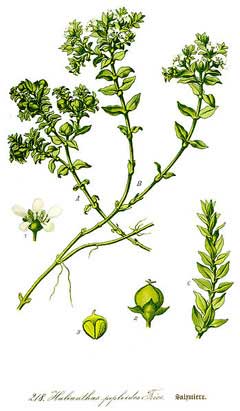 |
|
http://commons.wikimedia.org/wiki/File:Ilustration_Honckenya_peploides_clean.jpg |
 |
| http://commons.wikimedia.org/wiki/User:Slaunger |
Translate this page:
Summary
Physical Characteristics

 Honckenya peploides is a PERENNIAL growing to 0.2 m (0ft 8in) by 1 m (3ft 3in) at a medium rate.
Honckenya peploides is a PERENNIAL growing to 0.2 m (0ft 8in) by 1 m (3ft 3in) at a medium rate.
See above for USDA hardiness. It is hardy to UK zone 5 and is not frost tender. It is in flower from May to August, and the seeds ripen from July to September. The species is hermaphrodite (has both male and female organs) and is pollinated by Insects, wind, wind-blown sand. The plant is self-fertile.
Suitable for: light (sandy) and medium (loamy) soils, prefers well-drained soil and can grow in nutritionally poor soil. Suitable pH: mildly acid, neutral and basic (mildly alkaline) soils. It cannot grow in the shade. It prefers dry or moist soil. The plant can tolerate maritime exposure.
UK Hardiness Map
US Hardiness Map
Synonyms
Arenaria peploides.
Plant Habitats
Cultivated Beds;
Edible Uses
Edible Parts: Leaves Seed Shoots
Edible Uses:
Young shoots - raw or cooked and used as a potherb[2, 61, 183]. A sour taste[257]. A delicious flavour, they are rich in vitamins A and C[172, 257]. They are at their best before the plant flowers[172]. The leaves can also be fermented and used like sauerkraut[115, 257]. In Iceland the plant is steeped in sour whey and allowed to ferment. The resulting liquor is said to taste like olive oil and is used as a beverage[183]. Seed - used as a garnish or ground into a powder and added to flour[172]. Very fiddly to harvest[172].
References More on Edible Uses
Medicinal Uses
Plants For A Future can not take any responsibility for any adverse effects from the use of plants. Always seek advice from a professional before using a plant medicinally.
None known
References More on Medicinal Uses
The Bookshop: Edible Plant Books
Our Latest books on Perennial Plants For Food Forests and Permaculture Gardens in paperback or digital formats.

Edible Tropical Plants
Food Forest Plants for Hotter Conditions: 250+ Plants For Tropical Food Forests & Permaculture Gardens.
More

Edible Temperate Plants
Plants for Your Food Forest: 500 Plants for Temperate Food Forests & Permaculture Gardens.
More

More Books
PFAF have eight books available in paperback and digital formats. Browse the shop for more information.
Shop Now
Other Uses
References More on Other Uses
Cultivation details
Requires a well-drained soil and an open sunny position. Plants are tolerant of short periods of immersion in salt water[17]. When well sited, the plant can spread quite freely at the roots[K]. Grows well in an outdoor bed at Kew[K].
References Carbon Farming Information and Carbon Sequestration Information
Temperature Converter
Type a value in the Celsius field to convert the value to Fahrenheit:
Fahrenheit:
The PFAF Bookshop
Plants For A Future have a number of books available in paperback and digital form. Book titles include Edible Plants, Edible Perennials, Edible Trees,Edible Shrubs, Woodland Gardening, and Temperate Food Forest Plants. Our new book is Food Forest Plants For Hotter Conditions (Tropical and Sub-Tropical).
Shop Now
Plant Propagation
Seed - sow March in a cold frame. Prick out the seedlings into individual pots when they are large enough to handle and plant them out in the summer. Division in early spring. Very easy, larger clumps can be replanted direct into their permanent positions, though it is best to pot up smaller clumps and grow them on in a cold frame until they are rooting well. Plant them out in the spring.
Other Names
If available other names are mentioned here
Native Range
TEMPERATE ASIA: Russian Federation (Yakutia-Sakha (north), Taymyr (north), Jamalo-Neneckij avtonomnyj okrug (north)), Russian Federation (Kurile Islands, Habarovskij kraj, Primorye, Kamcatskij kraj, Magadanskaja oblast, Sakhalin), Korea, Japan (Hokkaidô, Honshu) NORTHERN AMERICA: Canada (Northwest Territories, Yukon (north), Québec (east), Nova Scotia, Prince Edward Island, New Brunswick, Newfoundland and Labrador, Manitoba (northeast), British Columbia (west)), Greenland, United States (Alaska (coastal), Connecticut, Maine (south), Massachusetts (east), New Hampshire (southeast), New Jersey, New York (southeast), Rhode Island, Oregon (northwest), Washington (west), Delaware, Maryland (east), Virginia (east)) EUROPE: Denmark, Finland, United Kingdom, Ireland, Iceland, Norway, Sweden, Belgium (north), Germany (north), Netherlands (north), Poland (north), Russian Federation-European part (European part (north)), Estonia, Lithuania, Latvia, Spain (north), France (n. & w.), Portugal (west)
Weed Potential
Right plant wrong place. We are currently updating this section.
Please note that a plant may be invasive in one area but may not in your area so it's worth checking.
Conservation Status
IUCN Red List of Threatened Plants Status :

Growth: S = slow M = medium F = fast. Soil: L = light (sandy) M = medium H = heavy (clay). pH: A = acid N = neutral B = basic (alkaline). Shade: F = full shade S = semi-shade N = no shade. Moisture: D = dry M = Moist We = wet Wa = water.
Now available:
Food Forest Plants for Mediterranean Conditions
350+ Perennial Plants For Mediterranean and Drier Food Forests and Permaculture Gardens.
[Paperback and eBook]
This is the third in Plants For A Future's series of plant guides for food forests tailored to
specific climate zones. Following volumes on temperate and tropical ecosystems, this book focuses
on species suited to Mediterranean conditions—regions with hot, dry summers and cool, wet winters,
often facing the added challenge of climate change.
Read More
Expert comment
Author
(L.)Ehrh.
Botanical References
17
Links / References
For a list of references used on this page please go here
Readers comment
© 2010, Plants For A Future. Plants For A Future is a charitable company limited by guarantee, registered in England and Wales. Charity No. 1057719, Company No. 3204567.